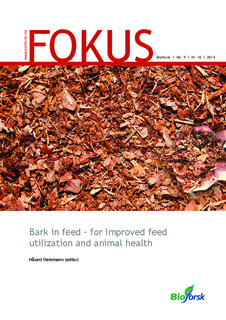| dc.description.abstract | Condensed tannins (CT) in the diet of ruminants may reduce feed intake and digestibility, and thereby production. However, dietary CT may increase protein utilization, reduce enteric methane loss and reduce gastrointestinal nematodes. The cultivation of tannin containing forages are limited in Norway, but bark of tree species that is harvested may have high quantities of CT. The objectives of the present study were to 1) assess the value of CT as feed additive; 2) assess the availability and the condition of Norwegian bark resources; 3) characterize the concentration, variation and type of CT in bark sampled from commercial sawmills and in fresh bark from logging sites; 4) evaluate the possibility for isolation and concentrating CT from bark, and 5) quantify the anthelmintic activity of selected bark extracts in vitro. - Few studies have tested bark or CT from bark in vivo. The literature review revealed that the studies conducted mainly focused on hydrolysable tannins, extracted from the wood of a chestnut species, and CT from the bark and wood of the tropical tree species (mimosa and quebracho). Anthelmintic activity of CT extracted from Scotts pine (Pinus sylvestris) has been demonstrated in laboratory test, and the addition of bark in the diet of goats of an American pine species (Pinus taeda) resulted in increased growth rate and reduced fecal egg count. - Total annual bark volume in Norway is estimated to be 642,665 m3 . About 60% of the bark is burned, which provides about 40% available for alternative use. A challenge is contamination of sand and soil. - The content of CT in bark samples taken from tree species in Middle Norway varied with the age of the tree at sampling, but on average, dry bark of pine contained 4.9, spruce 3.9 and birch 3% CT, respectively. Procyanidins were the dominant CT in all species (100% pine bark and 93% in spruce bark), but birch contained in addition on average 14% prodelfinidins. The average degree of polymerization, i.e. the size/chain length of the CT polymer, was 6.7, 9.0 and 5.8 in pine, spruce and birch, respectively. - We tested methods for isolation and purification of bark CT. Extraction with ethanol and acetone were compared, and 70% acetone gave the highest yield. - In selected bark samples, we tested their effect on egg hatching and motility inhibition in larvae of a parasitic nematode common in small ruminants (Teladorsagia circumcincta). Crude extract (water) and acetone extract was used. The results showed that both the crude and acetone extracts had an effect and reduced the egg hatching and impaired larvae motility. The birch extract seemed strongest, while extracts from spruce weakest. In pine, the crude extract had stronger effect than the than the extracts form acetone, which suggests that there may be other substances than CT that are anthelemintic. | nb_NO |
